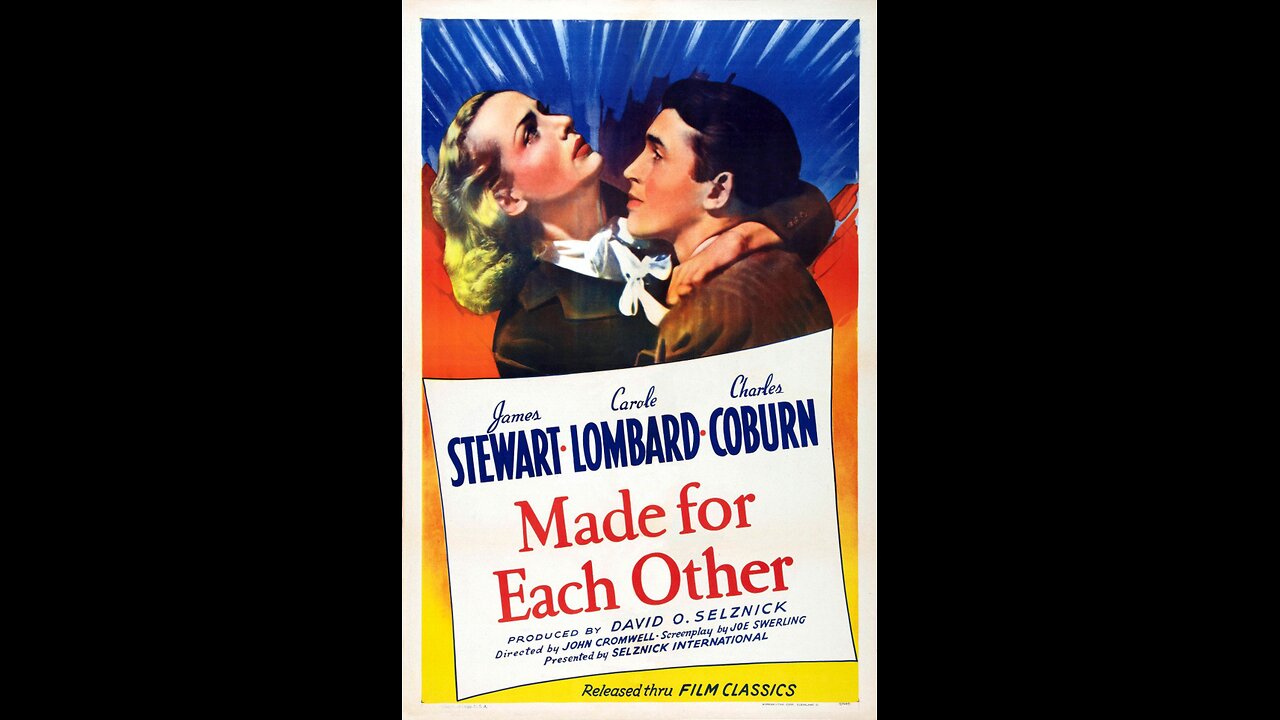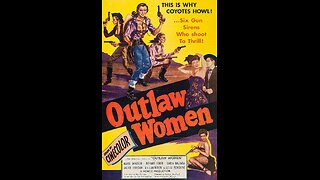Premium Only Content

Made for Each Other (1939) | Directed by John Cromwell
“Made for Each Other” is a romantic drama directed by John Cromwell. The film follows the newlywed couple John Mason (James Stewart) and Jane Mason (Carole Lombard). The story unfolds as they navigate the challenges of marriage, financial difficulties, and family dynamics. John, a young lawyer, faces professional pressures, while Jane contends with her overbearing mother-in-law (Lucile Watson). The couple’s love is put to the test as they confront a series of hardships.
Characterization and Performances:
James Stewart and Carole Lombard deliver heartfelt performances that capture the authenticity of their characters’ emotions. Stewart portrays John Mason with a blend of vulnerability and determination, while Lombard brings warmth and resilience to the role of Jane. The chemistry between the leads is palpable, anchoring the film in genuine emotion.
Realism and Domestic Drama:
“Made for Each Other” stands out for its realistic portrayal of the challenges faced by a young married couple. The film explores the complexities of balancing personal aspirations, career demands, and familial expectations. The domestic drama unfolds with a sense of authenticity, allowing the audience to connect emotionally with the characters.
Depiction of Marriage:
The film delves into the highs and lows of marriage, depicting the initial honeymoon phase, followed by the harsh realities of financial strain and external pressures. The narrative captures the evolving dynamics between John and Jane, showcasing the endurance and strength required to navigate the complexities of married life.
Supporting Cast:
Lucile Watson delivers a memorable performance as Mrs. Mason, John’s disapproving mother. The supporting cast, including Charles Coburn as John’s employer and Alma Kruger as John’s secretary, contributes to the overall narrative. The interactions between the characters add depth to the film’s exploration of family dynamics.
Direction and Cinematography:
John Cromwell’s direction emphasizes the intimate and personal aspects of the story. The cinematography, led by Leon Shamroy, complements the film’s emotional beats with visually evocative scenes. The use of lighting and framing enhances the mood and reinforces the film’s focus on the characters’ relationships.
Tonal Shifts and Genre Blending:
“Made for Each Other” skillfully navigates tonal shifts, blending elements of romance, drama, and even moments of lighthearted humor. The film’s ability to seamlessly transition between these tones adds richness to the storytelling, reflecting the complexities of real-life relationships.
Emotional Resonance:
The film succeeds in creating emotional resonance by presenting relatable challenges faced by its characters. The audience is drawn into the characters’ struggles, triumphs, and the transformative journey of their relationship. The film’s emotional impact lies in its ability to connect with viewers on a personal level.
Legacy and Reception:
While not as widely remembered as some of the iconic films of its era, “Made for Each Other” is appreciated for its genuine portrayal of marriage and the performances of its lead actors. Over the years, it has garnered recognition as a heartfelt exploration of love and commitment.
Conclusion:
“Made for Each Other” remains a poignant and sincere portrayal of the challenges inherent in marriage. With strong performances, a well-crafted narrative, and a focus on authentic emotions, the film stands as a testament to the timeless themes of love, resilience, and the enduring bonds that connect couples in the face of life’s trials.
-
 1:15:12
1:15:12
Classic Films & Movies Archive
2 days agoOutlaw Women (1952) | Directed by Sam Newfield & Ron Ormond
942 -
 6:57
6:57
Cooking with Gruel
16 hours agoMake Cheese Great Again
6.42K6 -
 5:17
5:17
Mrgunsngear
19 hours ago $1.73 earnedPresident Trump Has Appointed A New ATF Director
15.8K22 -
 48:17
48:17
Athlete & Artist Show
8 days agoS5E1: Chucky Announces First Kid, 4 Nations Face Off, and more!
6.35K -
 38:30
38:30
hickok45
5 hours agoSunday Shoot-a-Round # 269
10K9 -
 1:39:55
1:39:55
Squaring The Circle, A Randall Carlson Podcast
1 day ago#040 Humanity's Expansion Into The Cosmos: A New Age - Squaring The Circle
7.84K3 -
 12:54
12:54
ariellescarcella
14 hours agoYou're NOT Queer, Just Annoying And Boring
4.94K5 -
 18:57
18:57
Fit'n Fire
11 hours agoA PDW That Thumps -- Stribog SP45A3 45ACP
10.1K1 -
 2:06:23
2:06:23
Game On!
14 hours ago $0.77 earnedAnother Sunday Without Football...
21.9K1 -
 17:53
17:53
Forrest Galante
15 hours agoHow I Joined a Dangerous Remote Tribe (feat. Nelk Boys)
78.3K13